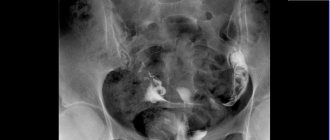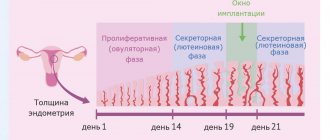- home
- Gynecology
- Adhesions in the pelvis
Interview with Prof. Puchkov on Medical Channel 1 on the topic: “Adhesive disease and infertility”
Adhesions in the pelvis are adhesions of connective tissue that appear on the surface of the pelvic organs. As a result, their mobility is limited and function may be impaired. When these organs are displaced, the adhesions become tense, which leads to pain.
The formation of adhesions refers to a protective reaction of the body aimed at delimiting a pathological focus from healthy tissues that appears due to various reasons: trauma, inflammation, exposure to air, circulatory disorders, etc. With any damage, the body strives to grow a new one on the unprotected area of the mesothelium, and substances are released , synthesizing fibrin. As a result, nearby organs are “glued together” with fibrin fibers.
Most often this occurs during surgical interventions, for example, after myomectomy, and adhesions in the pelvis after cesarean section are not uncommon. They also appear in urgent conditions associated with bleeding (for example, during ectopic pregnancy, ovarian apoplexy, abscesses, etc.), and adhesions in the pelvis in women are formed due to various diseases, for example, endometriosis, salpingitis, oophoritis, fibroids. The likelihood of the formation of adhesions depends on a number of factors: the properties of connective tissue determined genetically, weakened immunity and the individual predisposition of tissues to adhesions.
What are adhesions in gynecology
Adhesive disease of the pelvic organs in women is a complication after which fibrinous connective tissue grows between the pelvic and abdominal organs.
In this way, the body tries to protect the source of inflammation - due to excess tissue, the fallopian tubes, uterus, ovary and intestinal loops stick together, pull tightly together, which disrupts their functions. Adhesive processes can be of several types, depending on the “neglect”:
- Formation of single thin adhesions (synechia).
- Synechiae become denser, covering up to 50% of the surface of the ovary.
- The adhesions are dense and numerous, changing the position of organs or causing their deformation.
Adhesions cause pain and disturbances in the functioning of the pelvic organs. They appear after gynecological diseases or operations and can lead to serious complications: ectopic pregnancy, infertility, frequent inflammation and more.
To prevent the occurrence of adhesions, avoid complications and prescribe competent treatment, make an appointment with the doctors of the Doctor A clinic. We employ gynecologists of the first and highest qualification categories
Causes
Most often, synechiae occurs as a result of previous salpingitis (inflammation of the fallopian tubes). The timeliness and adequacy of the therapy reduces the risk of developing adhesions, but does not eliminate it 100%.
Much less often, the closure of the lumen of the fallopian tubes is caused by other reasons:
1. Fallopian tube endometriosis
: a hormonal pathology in which the endometrium of the uterus grows beyond the organ.
2. STD
(sexually transmitted diseases): genital herpes, gonorrhea, syphilis, chlamydia, etc.
3. Inflammatory diseases of the pelvic organs
: any inflammatory processes in the vagina, cervical canal, ovaries, uterus or lower intestines can provoke the growth of fallopian tube adhesions.
4. Surgical interventions
: complication after procedures such as abortion, cesarean section, uterine curettage, hysterosalpingography, etc.
Sometimes synechia develops against the background of long-term use of immunosuppressants or strong antibiotics, which cause activation of pathogenic microflora.
What causes adhesions to form in the pelvis
Inflammation of the pelvic organs. The disease is diagnosed in women who have suffered acute inflammation or suffer from chronic:
- colpitis;
- endometritis;
- andexite;
- parametritis and other diseases.
Operations. Adhesive disease appears in 16% of those operated for the first time and in 96% of women after the third operation. The percentage is high for laparotomy operations:
- appendectomy;
- C-section;
- removal of appendages;
- hysterectomy;
- supravaginal amputation.
Pelvic hemorrhages. The trigger is ovarian apoplexy, bleeding due to a ruptured tube during an ectopic pregnancy.
Endometriosis. The formation of fibrinous ties is provoked by endometrioid growths, which spread to the organs and peritoneum of the pelvis.
Pelvic injuries. Open and closed damage after accidents, falls from a height received at work are one of the reasons for the appearance of adhesions.
Predisposing factors. The occurrence and development of the disease is influenced by:
- invasive gynecological interventions;
- promiscuous sex life;
- late visit to the clinic.
Contraindications for surgery
List of contraindications for laparoscopic dissection of adhesions:
- acute infections and diseases;
- exacerbation of chronic pathology;
- severe damage to the heart, blood vessels and respiratory tract (due to problems with anesthesia);
- severe damage to the kidneys, liver, digestion until the condition stabilizes;
- serious and uncorrectable metabolic problems;
- blood clotting disorders;
- pregnancy period.
After the examination, the doctor can determine other individual contraindications, for example, allergies or intolerance to anesthesia or medications, and then the issue of intervention is decided individually.
Adhesions in gynecology: symptoms
The adhesive process can be both acute and chronic, or have a periodic nature (with periodic exacerbation of symptoms). Often, women do not notice any symptoms of adhesions in the pelvis, and the disease is discovered only when examining the possible causes of infertility.
Signs of adhesions in the pelvic cavity:
- Painful sensations in the lower abdomen, lower back, above the pubis or in the sacral area;
- Discomfort during physical activity, before menstruation, after stressful situations;
- Pain during sexual intercourse or urination;
- Intestinal disorders: diarrhea, constipation, flatulence;
- Periodic attacks of nausea and vomiting.
Symptoms may worsen when consuming foods that increase gas formation.
Progress of the operation
A woman may undergo surgery to remove adhesions in the fallopian tubes or dissection of adhesions in the area of the uterus, ovaries, and rectum. Before the intervention begins, the woman is given endotracheal general anesthesia. After the patient has fallen asleep, three incisions up to 2 cm long are made in the navel and bikini area. Through these holes, the doctor inserts instruments to manipulate the camera, air supply, and lighting. An inert gas is injected into the lumen of the pelvic cavity to lift the anterior abdominal wall and make work more comfortable. The surgeon examines the cavity, determines the presence of adhesions, grabs them with an instrument under the control of a video camera and carries out dissection and removal. Vessels damaged during the operation are cauterized with an electrocoagulator. After cutting the adhesions, the devices are removed from the punctures, sutures are placed on the incisions, processed and covered with a bandage.
Diagnosis of the disease
Diagnosis of adhesions in the pelvis is carried out using various studies:
- Diagnostic laparoscopy. This method can most accurately see adhesions and assess the severity of the process. Diagnosis is carried out under local (or general) anesthesia; a small incision is made through which a camera is inserted.
- Ultrasound of the pelvic organs;
- Hysterosalpingography (performed using X-rays or ultrasound and contrast agents);
- MRI of the pelvic organs.
The necessary examination (or set of examinations) will be prescribed to you by your attending physician.
Preparation
The operation is carried out as planned; before it, the woman must undergo a full examination in order to exclude contraindications and any health problems that require additional treatment. It is important to be examined by a gynecologist and undergo all the required tests, as well as a physician’s opinion on the possibility of surgery. You need to do:
- general blood test in combination with coagulation studies (blood for clotting), hormone levels, determination of biochemical parameters;
- urine tests to exclude urological infections;
- Ultrasound of the abdominal cavity and pelvis to determine the anatomical features of the body;
- research to exclude hepatitis, HIV and sexually transmitted infections.
2-3 days before surgery, a light diet, laxatives, and bowel cleansing are necessary. After 6 pm before the operation, it is forbidden to eat, and in the morning before the operation you should also not drink.
How to treat adhesions in the pelvis
What to do if adhesions are found in the pelvis? Depending on the severity of the adhesive process, the doctor will select the appropriate treatment for you.
To treat single thin adhesions in the pelvis in women, drug therapy is used. What is usually prescribed:
- Antibiotics and antimicrobial agents (to relieve inflammation);
- Non-steroidal anti-inflammatory drugs (as a pain reliever);
- Fibrinolytic agents (for resorption of adhesions);
- Vitamins and immune system regulators (to restore immune balance);
- Hormonal drugs (in cases where adhesions are caused by endometriosis).
Additionally, physiotherapy, balneotherapy and mud therapy may be prescribed as auxiliary measures.
In more severe forms of adhesive disease, a surgical method is used to treat adhesions in the pelvis, i.e. their dissection. The most gentle surgical procedure is manipulative laparoscopy. To prevent re-formation of adhesions, hyaluronic acid is injected into the surgical area.
Laparoscopic adhesiolysis of the pelvis
Surgical intervention is widely used today to treat adhesions, but it is carried out mainly by laparoscopic method. Adhesiolysis is used - dissection of pelvic adhesions using special surgical instruments that are inserted through punctures in the abdominal cavity. The operation is performed in an operating room using anesthesia, but the intervention itself is not as traumatic as a full-fledged operation with incisions. Adhesions are dissected and removed in order to restore the functionality of the organs of the female reproductive system and eliminate intestinal problems. This is the safest and most effective method, after which a woman quickly recovers and can live a full life.
Is it possible to get pregnant during adhesions?
Adhesions disrupt the proper functionality of the reproductive organs, which greatly reduces the chance of getting pregnant. There is a chance of pregnancy and its successful gestation, especially in cases where the adhesive process affected only one tube. But the likelihood of conception decreases, and the risk of ectopic pregnancy and miscarriage also increases.
In this case, IVF may help. The fallopian tubes are not involved in such fertilization, and a 3-5-day-old embryo is immediately implanted into the uterine cavity.
Postoperative period
The recovery period after the intervention is not long. If there are no complications or complaints, the patient goes home the next day; pain and discomfort in the abdominal area disappear within 3-4 days after the intervention. Full recovery takes up to 4-6 weeks. During this time, a diet is needed to prevent gas formation and intestinal overload, limiting exercise, a temporary ban on intimate life, visiting a sauna, bathhouse.
After surgery, the sutures are treated with antiseptics for 6-7 days, then they are completely tightened. As they recover, they become almost invisible.
Prevention of adhesions
For the prevention and treatment of adhesions, enzyme preparations based on hyaluronidase are used. Perhaps the most popular drug for the treatment of adhesions in gynecology is Longidaza suppositories.
Prevention is mostly aimed at preventing relapses of the disease or before an upcoming operation (since adhesions often appear after them).
Remember that the best prevention is regular visits to the doctor and timely diagnosis. Don’t delay until later and sign up for a pelvic ultrasound or a consultation with a gynecologist.
If you feel acute pain in the abdominal cavity or pelvic organs, do not delay visiting a doctor - prevent the development of the disease. Doctors at the Doctor A clinic will conduct an expert examination and prescribe competent treatment. Call or make an appointment online.
How to reduce the risk of formation of adhesions on the fallopian tubes?
The main preventive measures are as follows:
- Prevention of inflammatory processes in the genital organs. To do this, it is recommended to avoid casual sex, use barrier methods of contraception (condom), monitor intimate hygiene and regularly visit a gynecologist for preventive examinations, because Many infections can remain asymptomatic for a long time.
- Reliable contraception to prevent unplanned pregnancy and associated abortions. Today, the most effective and recommended is hormonal protection. A gynecologist will help you choose the most optimal drug.
- If possible, conservative rather than surgical treatment of gynecological diseases. Any operation, even the most gentle laparoscopic one, leaves its mark. Taking into account the individual characteristics of collagen formation, there are categories of women who are distinguished by a pronounced adhesive process that developed after surgery.
For all questions of reproductive health, please contact the SM-Clinic clinic. Our staff includes qualified gynecologists, reproductive specialists and doctors of related specialties who work as a team to help you realize your dream of motherhood. The SM Clinic has introduced advanced diagnostic and treatment methods, incl. use of assisted reproduction methods.
Principles of treatment
Treatment of adhesions and elimination of the adhesive process is possible using conservative methods of therapy. These include:
- The use of physiotherapy is the impact of ultrasound, high-frequency current, magnetic waves on the commissure and the area where it is located. This allows you to slow down the process of proliferation of connective tissue.
- Drug treatment.
If adhesions are detected, surgical intervention by doctors is required. Surgical treatment will help solve this gynecological problem by eliminating already formed adhesions. The operation is a dissection of the commissure and is usually performed laparoscopically - through small punctures and under video control. If possible, the adhesive tissue is removed, and the attachment sites of the adhesions are cauterized using electrodes. Recovery after removal of scar tissue through laparoscopic access lasts several weeks. In the postoperative period, the woman is under the supervision of specialists.











